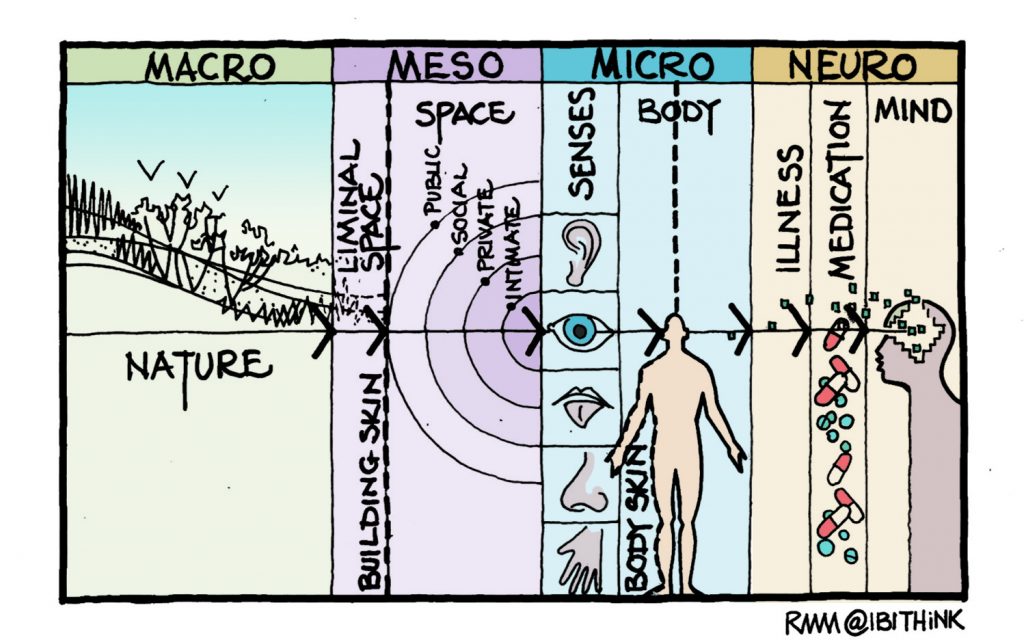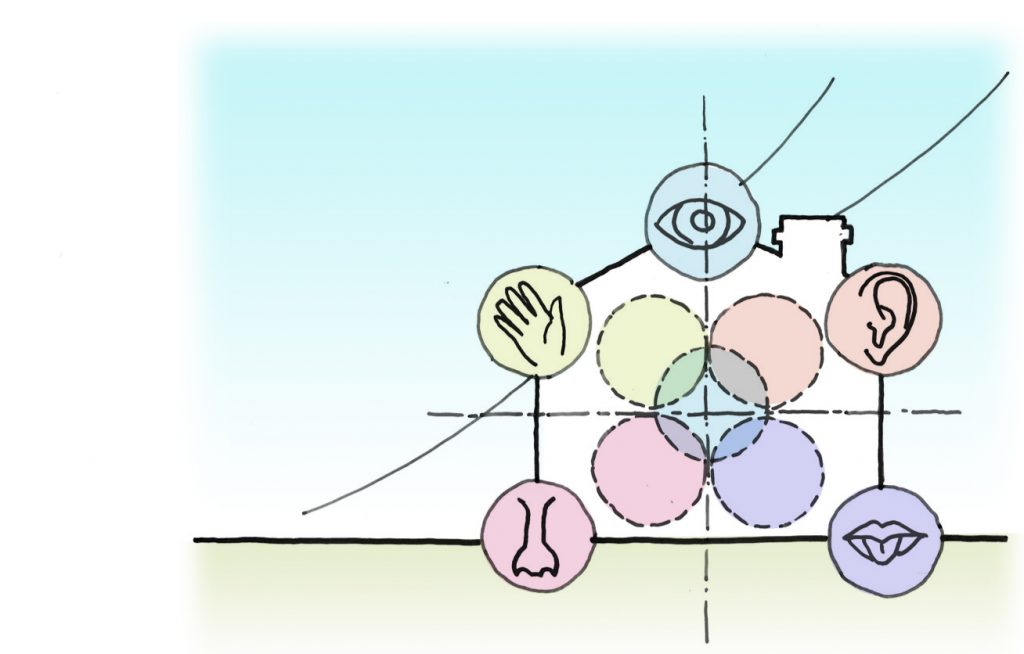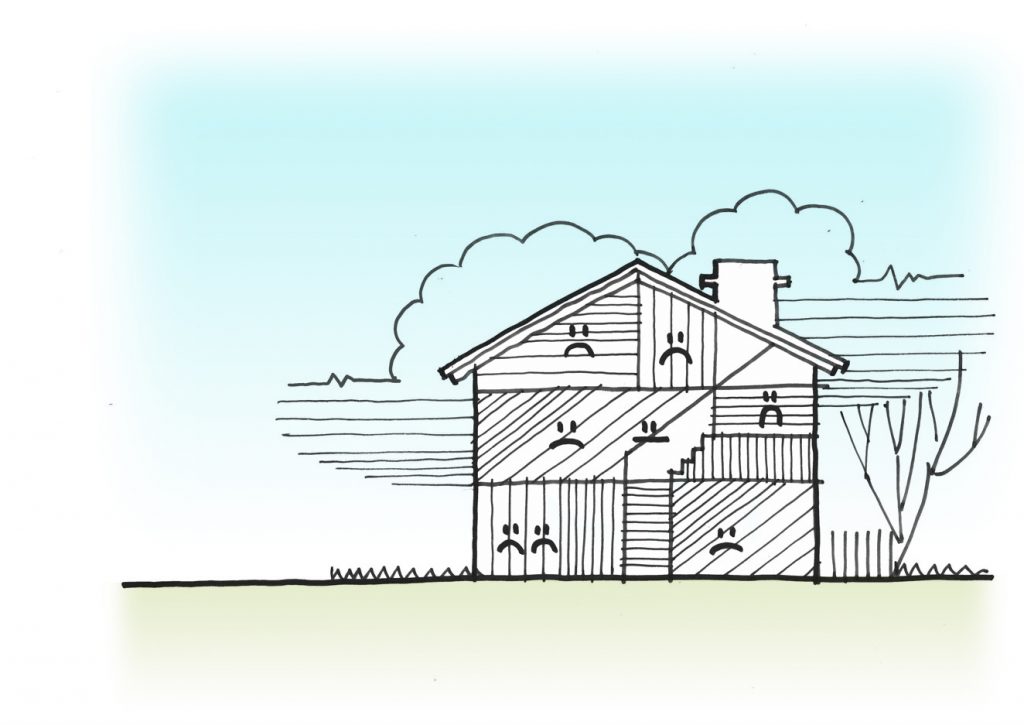Mental Health at Home: Issues, Solutions and Interventions
Date
October 22, 2019One in four people in England experience a mental health problem each year, costing the UK more than £94 billion every year. (Public Finance, November 2018).
Home has a major impact on our mental health. Depending on the context, home can be a ‘sanctuary’ as well as a place of major stress. So why is it that mental health is rarely discussed as part of home design? Research informs us that the majority of mental health issues germinate at early childhood and are established by adolescence. However, when assessing the broader picture, emotional health issues inhabit all stages of our lives. Such issues include: loneliness, self-worth/esteem, post/prenatal depression, isolation, obsessive compulsive disorder, chronic fatigue syndrome, sleep deprivation, obsessive compulsive disorders, bipolar depression, and dementia.
Our attention is usually focused on dealing with the effects of mental health rather than the cause. We have a real opportunity to make a difference by investigating the source of mental health issues in the domestic setting. By harnessing assistive design and technology to support neuro diversity and the varying profiles of mental soundness, we can offer major contributions to the Third Era of Health.
Home Sweet Home
The home should be a supportive environment in which to grow and discover ourselves, a place of happiness, mindfulness and wellness. Ideally homes should be places of comfort and safety, offering shelter from the elements and the stressors of the outside world.
When our home life is not ideal, it can ultimately become a place of anxiety, distress, extreme sadness and grief. At its worst, it can be unsafe, generating feelings of fear and entrapment. Life events such as retirement, old age, absence of familial support, physical disabilities etc., can prove to be disempowering and debilitating.
The key to understanding mental health is to assess our own dialogical interactions with space, alongside our related interpersonal communication. Most people value their personal spaces and feel discomfort, anxiety and distress when these spaces are encroached.
 Click here to view larger image.
Click here to view larger image.
Many homes experience volatile ‘pressure cooker’ scenarios, ‘flash point’ moments, emotional outbursts, etc. The design and planning of the home should enable individuals to freely retire to multiple de-escalation spaces. Many schools, nurseries and rehab centres offer calming rooms for withdrawal with the aim of de-escalating from a current emotional state within a safe space. Every home should incorporate a variety of personal, decompression, de-escalation, and safe spaces where one can freely withdraw from the noisy hubbub of daily life or simply step away from others. These spaces can offer quiet moments of reflection and contemplation or just simple distraction.
Researchers have consistently reported the stress-reducing and restorative benefits of looking at nature. Clinical research illustrates how viewing nature can rapidly calm and sedate us by lowering our respiration rate, blood pressure and heart rate while early morning sunlight has been proven to substantially accelerate bipolar recovery. Within a domestic setting, one may consider framing, composing, and landscaping outdoor space, as viewed from within.
Biophilic Design
Biophilic design is an innovative and rapidly growing method of designing the spaces within which we live. The most significant benefits of biophilia can be seen in healthcare applications to improve mental health and physical wellbeing. Recent research supports measurable, positive outcomes of biophilic design on health that can expedite healing. Ben Channon in his book Happy by Design – A Guide to Architecture and Mental Wellbeing states that “regardless of other factors ‘nature relatedness’ is a reliable predictor of happiness”. Increasingly, clinicians are referring patients to nature-based interventions. Their ‘green prescriptions’ include gardening, fitness activities, reiki, yoga and growing vegetables in adjacent allotments.
Calming and Energizing Spaces
Calming and energising spaces can also positively impact mental wellness at home. Relaxing environments can be established to calm and reduce agitation by using dimmed, warm spectral light, temperature adjustment, soothing soundscapes, relaxing scent emitters, etc. On the other hand, an energizing ambiance can be stimulated by increasing blue spectral light, dynamic visuals, up-tempo soundscapes, and invigorating seascape smells.

Sleep – Reboot Body, Mind and Design
We spend approximately one-third of our life in our bedrooms. We reboot our mind and body here daily to empower us to engage with a new day. A lack of sleep increases the risk of medical conditions including diabetes, heart disease and obesity which places strain on our mental health and shortens life expectancy. Recent research by Rand Europe, November 2016, informs us that lack of sleep costs the UK approximately £40 billion a year. So what can we do to improve the situation?
Remarkably, many solutions may have little or no cost impact, such as: correct colour ways, bed inclination, amber, night time illumination, bed/WC orientation, biophilic design and curfew arrangements. More advanced solutions include the Med Bedhead, sensory doors, robotics, smart floors, LED WC seats, LED pillows.
Digital Mental Health
Today, digital technology assists us in the treatment of common mental health conditions. The use of electronic and communication technologies as a therapeutic and mental health care practice is beginning to come to the fore. It is commonly referred to as Telemedicine or eHealth.
Augmented Reality (AR) and Virtual Reality (VR) technology can help desensitize post-traumatic stress disorders, helping people to develop coping techniques within the safety of the home. Mental health apps such as: Calm, Moodnotes, Headspace, Pacifica and Talkspace have proven very effective for younger people who are more likely to suffer from stress and anxiety. On the flip side, technology can also disrupt sleep through blue light emissions, intermittent sonic reminders and it’s pressure for us to remain connected 24/7.
The Third Era of Health presents very real opportunities to deliver optimal neuro-supportive environments embedded in the homes of tomorrow. Let us find new ways to inform and empower residents to actively choreograph their respective domestic spaces to address neuro diversity within the growing percentile of multi-generational homes. A better the relationship between people, their mental health and relationship to their environment will clearly inform the design of tomorrow’s salutogenic home and ultimately help staunch the daily increase in mental health statistics.
A longer version of this article was originally published in The Network in July 2019.
Richard Mazuch, Director of Design Research and Innovation, is an architect and designer who gains great satisfaction from translating holistic ideas into radical but pragmatic solutions. An authority on healthcare, he provides profound insight into designing for global trends, patient groups and clinical provision – informing key decisions throughout the architectural process. He has worked on numerous healthcare projects and has been elected as a World Architecture Jury member, as well as being a university lecturer/examiner and speaker at international conferences. Richard has strong relations with key health bodies and has worked extensively with the NHS contributing to Health Building Notes (HBNs), Health Technical Memorandum (HTM), and their ‘Therapeutic Environment’ website feature entitled ‘Sight Sensitive Design’ and Sound Sensitive Design’ enabling designers to build evidence-based healthcare environments.
Richard Mazuch is an architect and designer who gains great satisfaction from translating holistic ideas into radical but pragmatic solutions. An authority on healthcare, Richard provides profound insight into designing for global trends, patient groups and clinical provision – informing key decisions throughout the architectural process. Richard has worked on healthcare projects in Italy, Hong Kong, Brazil, Oman, UAE, and more recently Australia. He has been elected as a World Architecture Jury member, as well as being a University lecturer/examiner and speaker at the International Conferences. Richard has strong relations with key health bodies. He has worked extensively with the NHS contributing to Health Building Notes, Health Technical Memorandum, and their ‘therapeutic environment’ website feature entitled “Slight Sensitive Design and Sound Sensitive Design” enabling designs to build evidence-based healthcare environments. Richard is a founder and champion of IBI TH!NK. An advocate of evidence-based design, Richard creates innovations that positively impact the psychology and physiology of patient groups. Sense Sensitive Design, Emotional Mapping, the Design Prescription and the hPod are a few of the models that Richard has successfully pioneered. This has led to him co-authoring two new NHS guidelines for ‘Evidence-based Design Healthcare Environments’. Richard works frequently with the NHS and DOH Expert Working Groups and Reference Groups helping to develop new Healthcare Strategies and Guidelines. More recently he has co-authored three key Paediatric Guideline documents entitled: ‘Hospital Accommodation for children and young peopleHBN 23’, ‘Friendly healthcare environments for children and young people’ and ‘Mental Health faculties for children and young people’. Richard was also an active member and contributor to the Expert Reference Group responsible for ‘Facilities for Maternity Care’ HBN21. He was a key contributor to ‘The Children’s National Service Framework’ an NHS and Department of Health document with evaluation process and recommendations Richard made early contributions and document reviews of ‘Creating a Better Health Environment’ an Audit Took Kit by The National Childbirth Trust in 2003.
Richard is a product designer. In collaboration with manufacturers, he creates interventions, such as the BedPod, to support and improve patient care.
In education, Richard is translating his work in healthcare paediatrics to benefit teachers and students. Working alongside University partners, he is pioneering the development of an ‘optimal learning environment’, improving motivation, behaviour and concentration amongst pupils, especially those with special educational needs.









